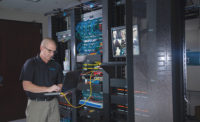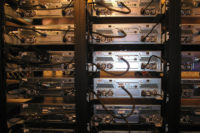NVRs vs. DVRs: What's Best for You?
Both will have a critical role to play in an effective video solution for the foreseeable future.

A technician with BCD International installs an NVR drive into an array earmarked for use by a security integrator in a new video surveillance system.
IMAGE COURTSY OF BCD INTERNATIONAL





Veteran security professionals are sure to agree that the technological progress made in the video surveillance industry over the past 20 years is nothing less than remarkable. Particularly on the recording side, what equipment manufacturers have managed to do is make something that was already good even better.
There’s a divergence of ideas within the rank and file of alarm dealers and security integrators that center on the use of analog versus digital data/image storage systems. The question is, do analog video DVRs (Digital Video Recorders) continue to provide the industry with a cost-effective, viable means of video storage? Or, is the industry steadily moving toward an all-digital NVR solution?
The Always Present DVR
In a survey taken earlier this year in the Surveillance Installers forum on Facebook, out of the 163 professionals that participated, 57 percent said they believe analog will never entirely go away. The forum, comprised of 11,000 members, contains professionals, manufacturers and end users.
“When the customer is trying to keep the cost down, I’ll use analog, although I’m not willing to cut labor costs,” says Timothy Brinton, owner and general manager of Frankton Telecommunications LLC of Dover, Pa. “When I have a tech working on the job that is great with wiring but doesn’t understand IP networking, I will also use analog. When I have a line run longer than 200m, I use analog. When we can save money by using an existing coax network, I use analog. Anyone that says they’ll never use analog is only limiting themselves.”
There’s no doubt that analog HD/DVRs are popular with some installers, while others claim they’ve never touched one and never will. In most instances, those who use HDcctv do so in residential and SMBs (small to midsize businesses). Those who say they won’t use analog usually default to digital IP cameras, which means the focus of these individuals is in larger commercial and institutional venues where network-based video is the rule and not the exception.
Selling Analog-Based Video
Like it or not, analog video appears to be here to stay.
. Some integrators may say they would rather not use it, offering any number of reasons; but there are still those that say it’s relevant and necessary.
Here are three reasons customers — particularly SMB — should consider an analog DVR:
- Analog video systems are simple to install, operate and maintain.
- They’re relatively affordable compared to traditional IP.
- Simple analog cameras are compatible with most other analog technologies.
There are two negatives associated with DVRs, however, you may want to make them aware of:
- Analog cameras are traditionally limited up to a D1 resolution (720 x 480 pixels), while more up-to-date systems provide a resolution of up to 960H (960 x 480 pixels).
- Where high-resolution images are necessary, this may be insufficient for applications requiring detail. Examples include license plate and facial recognition.
In retrofit and low-budget applications analog continues to offer the most for the least, and that’s probably never going to change, at least in the foreseeable future. Use it to your advantage where it makes sense to do so.
According to Ted Wilkinson, national sales director with Axis Communications, Chelmsford, Mass., “These days you’re most likely to find analog systems in smaller installations within budget-sensitive markets. For many of these customers, basic analog service still suffices. That said, there are analog users who want some of the benefits of IP systems but they’re reluctant to scrap their existing system or they are limited by budget. In these situations hybrid systems are still an attractive alternative.”
One thing is for certain, DVRs in general have undergone tremendous advancements. Today’s analog DVR usually supports both Composite SD (Standard Definition) and HD (High Definition) HDcctv cameras, all of which rely on RG59 and RG6 coaxial cable. The latter utilizes HD-TVI, HDCVI, AHD, and/or CVBS formats, which rely on modulating video data onto a carrier signal, sending it up the coax to the DVR at the head end. Many of the same DVRs also support IP.
“DVRs are not as common as they used to be, but we are seeing a resurgence with analog HD cameras,” says Aaron Saks, product and technical manager with Hanwha Techwin America, Ridgefield Park, N.J. “People want to keep their cabling and power infrastructure in place, and upgrade to HD. They can now replace their DVR and applicable cameras, while leaving certain cameras in place.”
The Power of NVR-Based Video Surveillance Systems
Ready and nearly instantaneous access to video — both live and stored — is extremely important in large commercial and institutional settings
Add the enterprise level to the equation and you have an extremely compelling reason to install a regiment of NVRs (Network Video Recorders) in each and every facility.
Analog-based DVRs also will provide security officers and facility managers with remote access to cameras, even in an enterprise setting. But when it comes down to it, these video storage devices are usually used in smaller installations of up to 32 cameras. When you exceed this number, or where it’s an enterprise-level application, security integrators usually opt for a video servers equipped with larger storage capacities — not to mention additional bells and whistles.
Quite possibly, the most sought after benefit to an installation with a NVR at the forefront is storage space.
NVRs: Bigger, Better With More to Offer

This Tim Horton facility, and most others, is protected by a NVR with an outgoing connection to a centralized VMS for enterprise-level access, on-site storage, and overall system control by remote means.
IMAGE COURTESY OF LYON PALMER OF SHADOW SECURITY
There’s little doubt that when it comes to the storage of and easy access to video, NVRs are by far preferred in commercial and institutional settings over that of older DVRs. “I would say that currently NVR systems make up the majority of solutions in the industry and have exponentially grown over the last several years,” says Eugene Kozlovitser, technology director at BCD International, Buffalo Grove, Ill. “Outside of the cloud or hybrid cloud-based systems, the NVR market is strong and has become very versatile as edge devices get more complex and intuitive.”
Steven Valentin, project manager, Jacksonville with BCI Integrated solutions of Tampa Fl, agrees. “Application versatility on NVRs is much more robust than that of the DVR, which typically is used for analog-based cameras limited to the installation length of wire. NVRs, however, take advantage of being able to handle cameras anywhere in your network.”
The technology incorporated in an NVR, being newer and network oriented, offers higher-quality images with larger storage capacities. In many cases, an integrator can install more than one SSD (Solid State Drive) or traditional magnetic hard drives as demands dictate over time — and at a lower price point than analog storage technologies.
The Cyber Protection of DVRs & NVRs
The need for cybersecurity where it comes to internet-connected NVRs and DVRs goes without saying.
The following is a compilation of what several key players in the video surveillance storage scene are doing to solve this problem from the manufacturer’s perspective.
Axis Communications
For Axis, cybersecurity begins with product development and this is one reason why the firm fully develop their own chip technology. The Axis ARTPEC chip provides an added layer of control and protection which includes signed firmware and secure boot to prevent the booting of unauthorized firmware. Additionally, teams like Axis Software Security Group (SSG) work with the company’s development engineers to apply cybersecurity best practices in design, development, and testing in order to minimize risks.
BCD International
From the NVR manufacturer standpoint, BCD has been designing and implementing its servers to be cybersecure and ready out of the box. With pre-configured, and hardened system images, TPM enabled functionality and encrypted data storage — to name a few — BCD is trying to simplify the process for the integrator or end user by making its systems reliable and secure with minimal site configuration.
Bosch Security Systems
Bosch has taken the steps to provide a connection to their remote cloud portal. This allows installers to easily connect cameras to the portal using installation software such as Bosch’s Configuration Manager and Project Assistant app. By having these cameras in the cloud, it’s a secure connection that allows for remote health monitoring and device management to easily update firmware.
Genetec Inc.
Deployment and system hardening tools for Genetec turnkey appliances help enforce best IT practices from the get-go or bring older systems up to speed. Every new unit comes with validated software and is cyber-hardened out of the box. Genetec offers maintenance tools and automation security software, camera firmware and Windows updates. Dynamic security dashboards keep cybersecurity top of mind and hassle-free, telling the client how well they score and which actions they need to take to further protect their video surveillance system.
Hanwha Techwin America.
Hanwha’s NVRs and DVRs come secure by default. This means that they do not have unnecessary ports and protocols running on them. Things like telnet or SSH or FTP are not present or running, thus eliminating an attack vector. Hanwha provides a tool to set up cameras and recorders that allow easy configuration and management capabilities.
IDIS America
IDIS realized from the outset the risks of potential cyber weaknesses for integrators and dealers who were familiar with analog deployments and would need time to acquire specialist knowledge of networks and cybersecurity techniques. To eliminate those risks, they took a zero-configuration approach. IDIS’ flagship DirectIP offering acts as a mutual authentication system whereby cameras and NVRs authenticate each other. The data is automatically stored on cameras and NVRs, thus eliminating the need for manual passwords that might be saved in vulnerable spreadsheets or simply written down.
“NVR-based systems undoubtedly offer the most cost-effective option for video storage, offering integrators and end users the benefit of simple and easy installation, low maintenance and the assurance of stable and high-performance, high- and ultra-definition recording and retention,” says Jeff Montoya, Eastern regional sales director for IDIS America, Coppell, Texas.
David Grey, product group senior manager, video appliances, Genetec, Montreal, Quebec, takes it one step further. He says that while NVR solutions using DAS (direct attached storage) have become the norm for medium to large deployments, consumers continue to look for more advanced solutions that are better suited for remote management and large-scale data analysis. “This can be accomplished using an NVR, but often is better addressed with a hybrid architecture where management is done in the cloud and some, or all, of the data remains on site,” he says.
While it’s assured that the video surveillance industry will continue is migration toward an all-IP video storage solution, the continued use of analog DVR technology is likely. However, the implementation of a more robust, fault-tolerant wireless solution may very well all but eliminate the need for analog in retrofit situations at some point ahead. To make this happen, traditional Wi-Fi will likely experience a number of upgrades, thus all but ending the apparent stranglehold that analog via metallic cable has had on our industry.
The Application of RAID Configurations in NVR Server Applications
A simple blackbox solution with a single HDD (Hard Disk Drive) or SSD (Solid State Drive) may be enough for low-level video surveillance applications, but it’s not going to cut the mustard in settings when government compliance or security is involved
When this type of application arises, it’s common practice to run storage drives in a RAID (Redundant Array of Independent Disks) configuration.
A RAID is a HDD or SSD that introduces increases a higher level of performance or fault tolerance — often both. Two or more drives are used in a RAID along with a RAID controller. The controller is connected to the motherboard(s) of a server. When the motherboard contains a RAID controller, this external controller is not needed.
The following is a short list of RAID configurations for reference:
RAID 0: This configuration is used in non-critical storage of high bit rate video data, such as high-resolution cameras with high frame rates. RAID 0 is not recommended for critical video surveillance.
RAID 1: Suitable for mission-critical storage applications, as in casinos, city surveillance and where regulatory compliance is required. This RAID level is also ideal for smaller video servers where two data drives are used..
RAID 6: This is an ideal configuration that balances the need for an efficient level of video storage with security and performance. It’s preferred over that of RAID 5 in critical video applications where many large physical drives are employed.
Looking for a reprint of this article?
From high-res PDFs to custom plaques, order your copy today!











